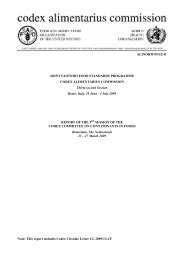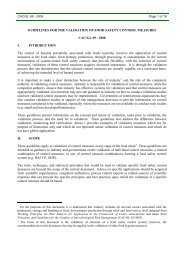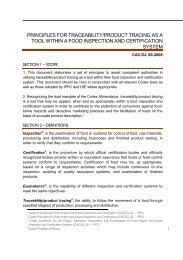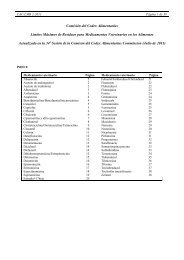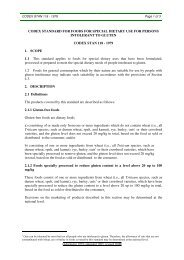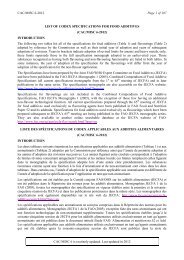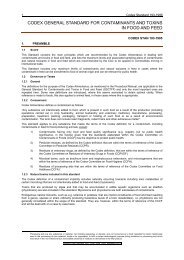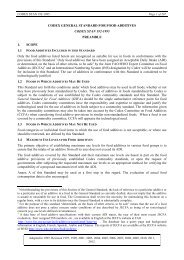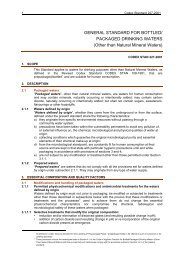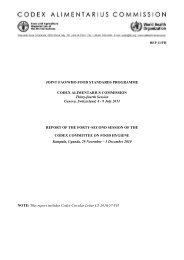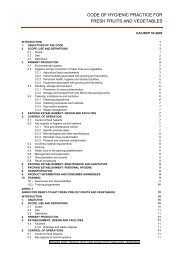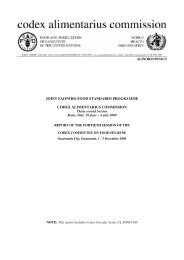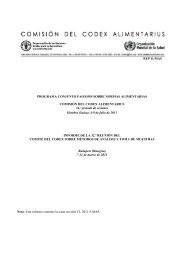Guideline for the Conduct of Food Safety Assessment
Guideline for the Conduct of Food Safety Assessment
Guideline for the Conduct of Food Safety Assessment
You also want an ePaper? Increase the reach of your titles
YUMPU automatically turns print PDFs into web optimized ePapers that Google loves.
-1-<br />
GUIDELINE FOR THE CONDUCT OF FOOD SAFETY ASSESSMENT OF FOODS<br />
DERIVED FROM RECOMBINANT-DNA PLANTS<br />
CAC/GL 45-2003<br />
SECTION 1 - SCOPE<br />
1. This <strong>Guideline</strong> supports <strong>the</strong> Principles <strong>for</strong> <strong>the</strong> Risk Analysis <strong>of</strong> <strong>Food</strong>s Derived from Modern Biotechnology. It<br />
addresses safety and nutritional aspects <strong>of</strong> foods consisting <strong>of</strong>, or derived from, plants that have a history <strong>of</strong> safe use as<br />
sources <strong>of</strong> food, and that have been modified by modern biotechnology to exhibit new or altered expression <strong>of</strong> traits.<br />
2. This document does not address animal feed or animals fed with <strong>the</strong> feed. This document also does not address<br />
environmental risks.<br />
3. The Codex principles <strong>of</strong> risk analysis, particularly those <strong>for</strong> risk assessment, are primarily intended to apply to<br />
discrete chemical entities such as food additives and pesticide residues, or a specific chemical or microbial contaminant<br />
that have identifiable hazards and risks; <strong>the</strong>y are not intended to apply to whole foods as such. Indeed, few foods have<br />
been assessed scientifically in a manner that would fully characterise all risks associated with <strong>the</strong> food. Fur<strong>the</strong>r, many<br />
foods contain substances that would likely be found harmful if subjected to conventional approaches to safety testing.<br />
Thus, a more focused approach is required where <strong>the</strong> safety <strong>of</strong> a whole food is being considered.<br />
4. This approach is based on <strong>the</strong> principle that <strong>the</strong> safety <strong>of</strong> foods derived from new plant varieties, including<br />
recombinant-DNA plants, is assessed relative to <strong>the</strong> conventional counterpart having a history <strong>of</strong> safe use, taking into<br />
account both intended and unintended effects. Ra<strong>the</strong>r than trying to identify every hazard associated with a particular<br />
food, <strong>the</strong> intention is to identify new or altered hazards relative to <strong>the</strong> conventional counterpart.<br />
5. This safety assessment approach falls within <strong>the</strong> risk assessment framework as discussed in Section 3 <strong>of</strong> <strong>the</strong><br />
Principles <strong>for</strong> <strong>the</strong> Risk Analysis <strong>of</strong> <strong>Food</strong>s Derived from Modern Biotechnology. If a new or altered hazard, nutritional<br />
or o<strong>the</strong>r food safety concern is identified by <strong>the</strong> safety assessment, <strong>the</strong> risk associated with it would first be assessed to<br />
determine its relevance to human health. Following <strong>the</strong> safety assessment and if necessary fur<strong>the</strong>r risk assessment, <strong>the</strong><br />
food would be subjected to risk management considerations in accordance with <strong>the</strong> Principles <strong>for</strong> <strong>the</strong> Risk Analysis <strong>of</strong><br />
<strong>Food</strong>s Derived from Modern Biotechnology be<strong>for</strong>e it is considered <strong>for</strong> commercial distribution.<br />
6. Risk management measures such as post-market monitoring <strong>of</strong> consumer health effects may assist <strong>the</strong> risk<br />
assessment process. These are discussed in paragraph 20 <strong>of</strong> <strong>the</strong> Principles <strong>for</strong> <strong>the</strong> Risk Analysis <strong>of</strong> <strong>Food</strong>s derived from<br />
Modern Biotechnology.<br />
7. The <strong>Guideline</strong> describes <strong>the</strong> recommended approach to making safety assessments <strong>of</strong> foods derived from<br />
recombinant-DNA plants where a conventional counterpart exists, and identifies <strong>the</strong> data and in<strong>for</strong>mation that are<br />
generally applicable to making such assessments. While this <strong>Guideline</strong> is designed <strong>for</strong> foods derived from recombinant-<br />
DNA plants, <strong>the</strong> approach described could, in general, be applied to foods derived from plants that have been altered by<br />
o<strong>the</strong>r techniques.<br />
SECTION 2 - DEFINITIONS<br />
8. The definitions below apply to this <strong>Guideline</strong>:<br />
“Recombinant-DNA Plant” - means a plant in which <strong>the</strong> genetic material has been changed through in vitro<br />
nucleic acid techniques, including recombinant deoxyribonucleic acid (DNA) and direct injection <strong>of</strong> nucleic acid<br />
into cells or organelles.<br />
“Conventional Counterpart” - means a related plant variety, its components and/or products <strong>for</strong> which <strong>the</strong>re is<br />
experience <strong>of</strong> establishing safety based on common use as food 1 .<br />
1<br />
It is recognized that <strong>for</strong> <strong>the</strong> <strong>for</strong>eseeable future, foods derived from modern biotechnology will not be used as conventional<br />
counterparts.<br />
Adopted in 2003, Annexes II and III adopted in 2008.
-2-<br />
SECTION 3 - INTRODUCTION TO FOOD SAFETY ASSESSMENT<br />
9. Traditionally, new varieties <strong>of</strong> food plants have not been systematically subjected to extensive chemical,<br />
toxicological, or nutritional evaluation prior to marketing, with <strong>the</strong> exception <strong>of</strong> foods <strong>for</strong> specific groups, such as<br />
infants, where <strong>the</strong> food may constitute a substantial portion <strong>of</strong> <strong>the</strong> diet. Thus, new varieties <strong>of</strong> corn, soya, potatoes and<br />
o<strong>the</strong>r common food plants are evaluated by breeders <strong>for</strong> agronomic and phenotypic characteristics, but generally, foods<br />
derived from such new plant varieties are not subjected to <strong>the</strong> rigorous and extensive food safety testing procedures,<br />
including studies in animals, that are typical <strong>of</strong> chemicals such as food additives or pesticide residues that may be<br />
present in food.<br />
10. The use <strong>of</strong> animal models <strong>for</strong> assessing toxicological endpoints is a major element in <strong>the</strong> risk assessment <strong>of</strong> many<br />
compounds such as pesticides. In most cases, however, <strong>the</strong> substance to be tested is well characterised, <strong>of</strong> known purity,<br />
<strong>of</strong> no particular nutritional value, and, human exposure to it is generally low. It is <strong>the</strong>re<strong>for</strong>e relatively straight<strong>for</strong>ward to<br />
feed such compounds to animals at a range <strong>of</strong> doses some several orders <strong>of</strong> magnitude greater than <strong>the</strong> expected human<br />
exposure levels, in order to identify any potential adverse health effects <strong>of</strong> importance to humans. In this way, it is<br />
possible, in most cases, to estimate levels <strong>of</strong> exposure at which adverse effects are not observed and to set safe intake<br />
levels by <strong>the</strong> application <strong>of</strong> appropriate safety factors.<br />
11. Animal studies cannot readily be applied to testing <strong>the</strong> risks associated with whole foods, which are complex<br />
mixtures <strong>of</strong> compounds, <strong>of</strong>ten characterised by a wide variation in composition and nutritional value. Due to <strong>the</strong>ir bulk<br />
and effect on satiety, <strong>the</strong>y can usually only be fed to animals at low multiples <strong>of</strong> <strong>the</strong> amounts that might be present in<br />
<strong>the</strong> human diet. In addition, a key factor to consider in conducting animal studies on foods is <strong>the</strong> nutritional value and<br />
balance <strong>of</strong> <strong>the</strong> diets used, in order to avoid <strong>the</strong> induction <strong>of</strong> adverse effects which are not related directly to <strong>the</strong> material<br />
itself. Detecting any potential adverse effects and relating <strong>the</strong>se conclusively to an individual characteristic <strong>of</strong> <strong>the</strong> food<br />
can <strong>the</strong>re<strong>for</strong>e be extremely difficult. If <strong>the</strong> characterization <strong>of</strong> <strong>the</strong> food indicates that <strong>the</strong> available data are insufficient<br />
<strong>for</strong> a thorough safety assessment, properly designed animal studies could be requested on <strong>the</strong> whole foods. Ano<strong>the</strong>r<br />
consideration in deciding <strong>the</strong> need <strong>for</strong> animal studies is whe<strong>the</strong>r it is appropriate to subject experimental animals to such<br />
a study if it is unlikely to give rise to meaningful in<strong>for</strong>mation.<br />
12. Due to <strong>the</strong> difficulties <strong>of</strong> applying traditional toxicological testing and risk assessment procedures to whole foods, a<br />
more focused approach is required <strong>for</strong> <strong>the</strong> safety assessment <strong>of</strong> foods derived from food plants, including recombinant-<br />
DNA plants. This has been addressed by <strong>the</strong> development <strong>of</strong> a multidisciplinary approach <strong>for</strong> assessing safety which<br />
takes into account both intended and unintended changes that may occur in <strong>the</strong> plant or in <strong>the</strong> foods derived from it,<br />
using <strong>the</strong> concept <strong>of</strong> substantial equivalence.<br />
13. The concept <strong>of</strong> substantial equivalence is a key step in <strong>the</strong> safety assessment process. However, it is not a safety<br />
assessment in itself; ra<strong>the</strong>r it represents <strong>the</strong> starting point which is used to structure <strong>the</strong> safety assessment <strong>of</strong> a new food<br />
relative to its conventional counterpart. This concept is used to identify similarities and differences between <strong>the</strong> new<br />
food and its conventional counterpart 2 . It aids in <strong>the</strong> identification <strong>of</strong> potential safety and nutritional issues and is<br />
considered <strong>the</strong> most appropriate strategy to date <strong>for</strong> safety assessment <strong>of</strong> foods derived from recombinant-DNA plants.<br />
The safety assessment carried out in this way does not imply absolute safety <strong>of</strong> <strong>the</strong> new product; ra<strong>the</strong>r, it focuses on<br />
assessing <strong>the</strong> safety <strong>of</strong> any identified differences so that <strong>the</strong> safety <strong>of</strong> <strong>the</strong> new product can be considered relative to its<br />
conventional counterpart.<br />
UNINTENDED EFFECTS<br />
14. In achieving <strong>the</strong> objective <strong>of</strong> conferring a specific target trait (intended effect) to a plant by <strong>the</strong> insertion <strong>of</strong> defined<br />
DNA sequences, additional traits could, in some cases, be acquired or existing traits could be lost or modified<br />
(unintended effects). The potential occurrence <strong>of</strong> unintended effects is not restricted to <strong>the</strong> use <strong>of</strong> in vitro nucleic acid<br />
techniques. Ra<strong>the</strong>r, it is an inherent and general phenomenon that can also occur in conventional breeding. Unintended<br />
effects may be deleterious, beneficial, or neutral with respect to <strong>the</strong> health <strong>of</strong> <strong>the</strong> plant or <strong>the</strong> safety <strong>of</strong> foods derived<br />
from <strong>the</strong> plant. Unintended effects in recombinant-DNA plants may also arise through <strong>the</strong> insertion <strong>of</strong> DNA sequences<br />
and/or <strong>the</strong>y may arise through subsequent conventional breeding <strong>of</strong> <strong>the</strong> recombinant-DNA plant. <strong>Safety</strong> assessment<br />
should include data and in<strong>for</strong>mation to reduce <strong>the</strong> possibility that a food derived from a recombinant-DNA plant would<br />
have an unexpected, adverse effect on human health.<br />
15. Unintended effects can result from <strong>the</strong> random insertion <strong>of</strong> DNA sequences into <strong>the</strong> plant genome which may cause<br />
disruption or silencing <strong>of</strong> existing genes, activation <strong>of</strong> silent genes, or modifications in <strong>the</strong> expression <strong>of</strong> existing genes.<br />
Unintended effects may also result in <strong>the</strong> <strong>for</strong>mation <strong>of</strong> new or changed patterns <strong>of</strong> metabolites. For example, <strong>the</strong><br />
expression <strong>of</strong> enzymes at high levels may give rise to secondary biochemical effects or changes in <strong>the</strong> regulation <strong>of</strong><br />
metabolic pathways and/or altered levels <strong>of</strong> metabolites.<br />
2 The concept <strong>of</strong> substantial equivalence as described in <strong>the</strong> report <strong>of</strong> <strong>the</strong> 2000 joint FAO /WHO expert consultations<br />
(Document WHO/SDE/PHE/FOS/00.6, WHO, Geneva, 2000).
-3-<br />
16. Unintended effects due to genetic modification may be subdivided into two groups: those that are "predictable" and<br />
those that are “unexpected”. Many unintended effects are largely predictable based on knowledge <strong>of</strong> <strong>the</strong> inserted trait<br />
and its metabolic connections or <strong>of</strong> <strong>the</strong> site <strong>of</strong> insertion. Due to <strong>the</strong> expanding in<strong>for</strong>mation on plant genome and <strong>the</strong><br />
increased specificity in terms <strong>of</strong> genetic materials introduced through recombinant-DNA techniques compared with<br />
o<strong>the</strong>r <strong>for</strong>ms <strong>of</strong> plant breeding, it may become easier to predict unintended effects <strong>of</strong> a particular modification. Molecular<br />
biological and biochemical techniques can also be used to analyse potential changes at <strong>the</strong> level <strong>of</strong> gene transcription<br />
and message translation that could lead to unintended effects.<br />
17. The safety assessment <strong>of</strong> foods derived from recombinant-DNA plants involves methods to identify and detect such<br />
unintended effects and procedures to evaluate <strong>the</strong>ir biological relevance and potential impact on food safety. A variety<br />
<strong>of</strong> data and in<strong>for</strong>mation are necessary to assess unintended effects because no individual test can detect all possible<br />
unintended effects or identify, with certainty, those relevant to human health. These data and in<strong>for</strong>mation, when<br />
considered in total, provide assurance that <strong>the</strong> food is unlikely to have an adverse effect on human health. The<br />
assessment <strong>for</strong> unintended effects takes into account <strong>the</strong> agronomic/phenotypic characteristics <strong>of</strong> <strong>the</strong> plant that are<br />
typically observed by breeders in selecting new varieties <strong>for</strong> commercialization. These observations by breeders provide<br />
a first screen <strong>for</strong> plants that exhibit unintended traits. New varieties that pass this screen are subjected to safety<br />
assessment as described in Sections 4 and 5.<br />
FRAMEWORK OF FOOD SAFETY ASSESSMENT<br />
18. The safety assessment <strong>of</strong> a food derived from a recombinant-DNA plant follows a stepwise process <strong>of</strong> addressing<br />
relevant factors that include:<br />
A) Description <strong>of</strong> <strong>the</strong> recombinant-DNA plant;<br />
B) Description <strong>of</strong> <strong>the</strong> host plant and its use as food;<br />
C) Description <strong>of</strong> <strong>the</strong> donor organism(s);<br />
D) Description <strong>of</strong> <strong>the</strong> genetic modification(s);<br />
E) Characterization <strong>of</strong> <strong>the</strong> genetic modification(s);<br />
F) <strong>Safety</strong> assessment:<br />
a) expressed substances (non-nucleic acid substances);<br />
b) compositional analyses <strong>of</strong> key components;<br />
c) evaluation <strong>of</strong> metabolites ;<br />
d) food processing;<br />
e) nutritional modification; and<br />
G) O<strong>the</strong>r considerations.<br />
19. In certain cases, <strong>the</strong> characteristics <strong>of</strong> <strong>the</strong> product may necessitate development <strong>of</strong> additional data and in<strong>for</strong>mation<br />
to address issues that are unique to <strong>the</strong> product under review.<br />
20. Experiments intended to develop data <strong>for</strong> safety assessments should be designed and conducted in accordance with<br />
sound scientific concepts and principles, as well as, where appropriate, Good Laboratory Practice. Primary data should<br />
be made available to regulatory authorities at request. Data should be obtained using sound scientific methods and<br />
analysed using appropriate statistical techniques. The sensitivity <strong>of</strong> all analytical methods should be documented.<br />
21. The goal <strong>of</strong> each safety assessment is to provide assurance, in <strong>the</strong> light <strong>of</strong> <strong>the</strong> best available scientific knowledge,<br />
that <strong>the</strong> food does not cause harm when prepared, used and/or eaten according to its intended use. The expected<br />
endpoint <strong>of</strong> such an assessment will be a conclusion regarding whe<strong>the</strong>r <strong>the</strong> new food is as safe as <strong>the</strong> conventional<br />
counterpart taking into account dietary impact <strong>of</strong> any changes in nutritional content or value. In essence, <strong>the</strong>re<strong>for</strong>e, <strong>the</strong><br />
outcome <strong>of</strong> <strong>the</strong> safety assessment process is to define <strong>the</strong> product under consideration in such a way as to enable risk<br />
managers to determine whe<strong>the</strong>r any measures are needed and if so to make well-in<strong>for</strong>med and appropriate decisions.<br />
SECTION 4 - GENERAL CONSIDERATIONS<br />
DESCRIPTION OF THE RECOMBINANT-DNA PLANT<br />
22. A description <strong>of</strong> <strong>the</strong> recombinant-DNA plant being presented <strong>for</strong> safety assessment should be provided. This<br />
description should identify <strong>the</strong> crop, <strong>the</strong> trans<strong>for</strong>mation event(s) to be reviewed and <strong>the</strong> type and purpose <strong>of</strong> <strong>the</strong><br />
modification. This description should be sufficient to aid in understanding <strong>the</strong> nature <strong>of</strong> <strong>the</strong> food being submitted <strong>for</strong><br />
safety assessment.
-4-<br />
DESCRIPTION OF THE HOST PLANT AND ITS USE AS FOOD<br />
23. A comprehensive description <strong>of</strong> <strong>the</strong> host plant should be provided. The necessary data and in<strong>for</strong>mation should<br />
include, but need not be restricted to:<br />
A) common or usual name; scientific name; and, taxonomic classification;<br />
B) history <strong>of</strong> cultivation and development through breeding, in particular identifying traits that may adversely<br />
impact on human health ;<br />
C) in<strong>for</strong>mation on <strong>the</strong> host plant’s genotype and phenotype relevant to its safety, including any known toxicity or<br />
allergenicity; and<br />
D) history <strong>of</strong> safe use <strong>for</strong> consumption as food.<br />
24. Relevant phenotypic in<strong>for</strong>mation should be provided not only <strong>for</strong> <strong>the</strong> host plant, but also <strong>for</strong> related species and <strong>for</strong><br />
plants that have made or may make a significant contribution to <strong>the</strong> genetic background <strong>of</strong> <strong>the</strong> host plant.<br />
25. The history <strong>of</strong> use may include in<strong>for</strong>mation on how <strong>the</strong> plant is typically cultivated, transported and stored, whe<strong>the</strong>r<br />
special processing is required to make <strong>the</strong> plant safe to eat, and <strong>the</strong> plant’s normal role in <strong>the</strong> diet (e.g. which part <strong>of</strong> <strong>the</strong><br />
plant is used as a food source, whe<strong>the</strong>r its consumption is important in particular subgroups <strong>of</strong> <strong>the</strong> population, what<br />
important macro- or micro-nutrients it contributes to <strong>the</strong> diet).<br />
DESCRIPTION OF THE DONOR ORGANISM(S)<br />
26. In<strong>for</strong>mation should be provided on <strong>the</strong> donor organism(s) and, when appropriate, on o<strong>the</strong>r related species. It is<br />
particularly important to determine if <strong>the</strong> donor organism(s) or o<strong>the</strong>r closely related members <strong>of</strong> <strong>the</strong> family naturally<br />
exhibit characteristics <strong>of</strong> pathogenicity or toxin production, or have o<strong>the</strong>r traits that affect human health (e.g. presence<br />
<strong>of</strong> anti-nutrients). The description <strong>of</strong> <strong>the</strong> donor organism(s) should include:<br />
A) its usual or common name;<br />
B) scientific name;<br />
C) taxonomic classification;<br />
D) in<strong>for</strong>mation about <strong>the</strong> natural history as concerns food safety;<br />
E) in<strong>for</strong>mation on naturally occurring toxins, anti-nutrients and allergens; <strong>for</strong> microorganisms, additional<br />
in<strong>for</strong>mation on pathogenicity and <strong>the</strong> relationship to known pathogens; and<br />
F) in<strong>for</strong>mation on <strong>the</strong> past and present use, if any, in <strong>the</strong> food supply and exposure route(s) o<strong>the</strong>r than intended<br />
food use (e.g. possible presence as contaminants).<br />
DESCRIPTION OF THE GENETIC MODIFICATION(S)<br />
27. Sufficient in<strong>for</strong>mation should be provided on <strong>the</strong> genetic modification to allow <strong>for</strong> <strong>the</strong> identification <strong>of</strong> all genetic<br />
material potentially delivered to <strong>the</strong> host plant and to provide <strong>the</strong> necessary in<strong>for</strong>mation <strong>for</strong> <strong>the</strong> analysis <strong>of</strong> <strong>the</strong> data<br />
supporting <strong>the</strong> characterization <strong>of</strong> <strong>the</strong> DNA inserted in <strong>the</strong> plant.<br />
28. The description <strong>of</strong> <strong>the</strong> trans<strong>for</strong>mation process should include:<br />
A) in<strong>for</strong>mation on <strong>the</strong> specific method used <strong>for</strong> <strong>the</strong> trans<strong>for</strong>mation (e.g. Agrobacterium-mediated trans<strong>for</strong>mation);<br />
B) in<strong>for</strong>mation, if applicable, on <strong>the</strong> DNA used to modify <strong>the</strong> plant (e.g. helper plasmids), including <strong>the</strong> source<br />
(e.g. plant, microbial, viral, syn<strong>the</strong>tic), identity and expected function in <strong>the</strong> plant; and<br />
C) intermediate host organisms including <strong>the</strong> organisms (e.g. bacteria) used to produce or process DNA <strong>for</strong><br />
trans<strong>for</strong>mation <strong>of</strong> <strong>the</strong> host organism.<br />
29. In<strong>for</strong>mation should be provided on <strong>the</strong> DNA to be introduced, including:<br />
A) <strong>the</strong> characterization <strong>of</strong> all <strong>the</strong> genetic components including marker genes, regulatory and o<strong>the</strong>r elements<br />
affecting <strong>the</strong> function <strong>of</strong> <strong>the</strong> DNA;<br />
B) <strong>the</strong> size and identity;<br />
C) <strong>the</strong> location and orientation <strong>of</strong> <strong>the</strong> sequence in <strong>the</strong> final vector/construct; and<br />
D) <strong>the</strong> function.<br />
CHARACTERIZATION OF THE GENETIC MODIFICATION(S)<br />
30. In order to provide clear understanding <strong>of</strong> <strong>the</strong> impact on <strong>the</strong> composition and safety <strong>of</strong> foods derived from<br />
recombinant-DNA plants, a comprehensive molecular and biochemical characterization <strong>of</strong> <strong>the</strong> genetic modification<br />
should be carried out.
-5-<br />
31. In<strong>for</strong>mation should be provided on <strong>the</strong> DNA insertions into <strong>the</strong> plant genome; this should include:<br />
A) <strong>the</strong> characterization and description <strong>of</strong> <strong>the</strong> inserted genetic materials;<br />
B) <strong>the</strong> number <strong>of</strong> insertion sites;<br />
C) <strong>the</strong> organisation <strong>of</strong> <strong>the</strong> inserted genetic material at each insertion site including copy number and sequence data<br />
<strong>of</strong> <strong>the</strong> inserted material and <strong>of</strong> <strong>the</strong> surrounding region, sufficient to identify any substances expressed as a<br />
consequence <strong>of</strong> <strong>the</strong> inserted material, or, where more appropriate, o<strong>the</strong>r in<strong>for</strong>mation such as analysis <strong>of</strong><br />
transcripts or expression products to identify any new substances that may be present in <strong>the</strong> food; and<br />
D) identification <strong>of</strong> any open reading frames within <strong>the</strong> inserted DNA or created by <strong>the</strong> insertions with contiguous<br />
plant genomic DNA including those that could result in fusion proteins.<br />
32. In<strong>for</strong>mation should be provided on any expressed substances in <strong>the</strong> recombinant-DNA plant; this should include:<br />
A) <strong>the</strong> gene product(s) (e.g. a protein or an untranslated RNA);<br />
B) <strong>the</strong> gene product(s)’ function;<br />
C) <strong>the</strong> phenotypic description <strong>of</strong> <strong>the</strong> new trait(s);<br />
D) <strong>the</strong> level and site <strong>of</strong> expression in <strong>the</strong> plant <strong>of</strong> <strong>the</strong> expressed gene product(s), and <strong>the</strong> levels <strong>of</strong> its metabolites in<br />
<strong>the</strong> plant, particularly in <strong>the</strong> edible portions; and<br />
E) where possible, <strong>the</strong> amount <strong>of</strong> <strong>the</strong> target gene product(s) if <strong>the</strong> function <strong>of</strong> <strong>the</strong> expressed sequence(s)/gene(s) is<br />
to alter <strong>the</strong> accumulation <strong>of</strong> a specific endogenous mRNA or protein.<br />
33. In addition, in<strong>for</strong>mation should be provided:<br />
A) to demonstrate whe<strong>the</strong>r <strong>the</strong> arrangement <strong>of</strong> <strong>the</strong> genetic material used <strong>for</strong> insertion has been conserved or<br />
whe<strong>the</strong>r significant rearrangements have occurred upon integration;<br />
B) to demonstrate whe<strong>the</strong>r deliberate modifications made to <strong>the</strong> amino acid sequence <strong>of</strong> <strong>the</strong> expressed protein<br />
result in changes in its post-translational modification or affect sites critical <strong>for</strong> its structure or function;<br />
C) to demonstrate whe<strong>the</strong>r <strong>the</strong> intended effect <strong>of</strong> <strong>the</strong> modification has been achieved and that all expressed traits<br />
are expressed and inherited in a manner that is stable through several generations consistent with laws <strong>of</strong><br />
inheritance. It may be necessary to examine <strong>the</strong> inheritance <strong>of</strong> <strong>the</strong> DNA insert itself or <strong>the</strong> expression <strong>of</strong> <strong>the</strong><br />
corresponding RNA if <strong>the</strong> phenotypic characteristics cannot be measured directly;<br />
D) to demonstrate whe<strong>the</strong>r <strong>the</strong> newly expressed trait(s) are expressed as expected in <strong>the</strong> appropriate tissues in a<br />
manner and at levels that are consistent with <strong>the</strong> associated regulatory sequences driving <strong>the</strong> expression <strong>of</strong> <strong>the</strong><br />
corresponding gene;<br />
E) to indicate whe<strong>the</strong>r <strong>the</strong>re is any evidence to suggest that one or several genes in <strong>the</strong> host plant has been affected<br />
by <strong>the</strong> trans<strong>for</strong>mation process; and<br />
F) to confirm <strong>the</strong> identity and expression pattern <strong>of</strong> any new fusion proteins.<br />
SAFETY ASSESSMENT<br />
Expressed Substances (non-nucleic acid substances)<br />
<strong>Assessment</strong> <strong>of</strong> possible toxicity<br />
34. In vitro nucleic acid techniques enable <strong>the</strong> introduction <strong>of</strong> DNA that can result in <strong>the</strong> syn<strong>the</strong>sis <strong>of</strong> new substances in<br />
plants. The new substances can be conventional components <strong>of</strong> plant foods such as proteins, fats, carbohydrates,<br />
vitamins which are novel in <strong>the</strong> context <strong>of</strong> that recombinant-DNA plant. New substances might also include new<br />
metabolites resulting from <strong>the</strong> activity <strong>of</strong> enzymes generated by <strong>the</strong> expression <strong>of</strong> <strong>the</strong> introduced DNA.<br />
35. The safety assessment should take into account <strong>the</strong> chemical nature and function <strong>of</strong> <strong>the</strong> newly expressed substance<br />
and identify <strong>the</strong> concentration <strong>of</strong> <strong>the</strong> substance in <strong>the</strong> edible parts <strong>of</strong> <strong>the</strong> recombinant-DNA plant, including variations<br />
and mean values. Current dietary exposure and possible effects on population sub-groups should also be considered.<br />
36. In<strong>for</strong>mation should be provided to ensure that genes coding <strong>for</strong> known toxins or anti-nutrients present in <strong>the</strong> donor<br />
organisms are not transferred to recombinant-DNA plants that do not normally express those toxic or anti-nutritious<br />
characteristics. This assurance is particularly important in cases where a recombinant-DNA plant is processed<br />
differently from a donor plant, since conventional food processing techniques associated with <strong>the</strong> donor organisms may<br />
deactivate, degrade or eliminate anti-nutrients or toxicants.
-6-<br />
37. For <strong>the</strong> reasons described in Section 3, conventional toxicology studies may not be considered necessary where <strong>the</strong><br />
substance or a closely related substance has, taking into account its function and exposure, been consumed safely in<br />
food. In o<strong>the</strong>r cases, <strong>the</strong> use <strong>of</strong> appropriate conventional toxicology or o<strong>the</strong>r studies on <strong>the</strong> new substance may be<br />
necessary.<br />
38. In <strong>the</strong> case <strong>of</strong> proteins, <strong>the</strong> assessment <strong>of</strong> potential toxicity should focus on amino acid sequence similarity between<br />
<strong>the</strong> protein and known protein toxins and anti-nutrients (e.g. protease inhibitors, lectins) as well as stability to heat or<br />
processing and to degradation in appropriate representative gastric and intestinal model systems. Appropriate oral<br />
toxicity studies 3 may need to be carried out in cases where <strong>the</strong> protein present in <strong>the</strong> food is not similar to proteins that<br />
have previously been consumed safely in food, and taking into account its biological function in <strong>the</strong> plant where known.<br />
39. Potential toxicity <strong>of</strong> non-protein substances that have not been safely consumed in food should be assessed on a<br />
case-by-case basis depending on <strong>the</strong> identity and biological function in <strong>the</strong> plant <strong>of</strong> <strong>the</strong> substance and dietary exposure.<br />
The type <strong>of</strong> studies to be per<strong>for</strong>med may include studies on metabolism, toxicokinetics, sub-chronic toxicity, chronic<br />
toxicity/carcinogenicity, reproduction and development toxicity according to <strong>the</strong> traditional toxicological approach.<br />
40. This may require <strong>the</strong> isolation <strong>of</strong> <strong>the</strong> new substance from <strong>the</strong> recombinant-DNA plant, or <strong>the</strong> syn<strong>the</strong>sis or<br />
production <strong>of</strong> <strong>the</strong> substance from an alternative source, in which case, <strong>the</strong> material should be shown to be biochemically,<br />
structurally, and functionally equivalent to that produced in <strong>the</strong> recombinant-DNA plant.<br />
<strong>Assessment</strong> <strong>of</strong> possible allergenicity (proteins)<br />
41. When <strong>the</strong> protein(s) resulting from <strong>the</strong> inserted gene is present in <strong>the</strong> food, it should be assessed <strong>for</strong> potential<br />
allergenicity in all cases. An integrated, stepwise, case-by-case approach used in <strong>the</strong> assessment <strong>of</strong> <strong>the</strong> potential<br />
allergenicity <strong>of</strong> <strong>the</strong> newly-expressed protein(s) should rely upon various criteria used in combination (since no single<br />
criterion is sufficiently predictive on ei<strong>the</strong>r allergenicity or non-allergenicity). As noted in paragraph 20, <strong>the</strong> data<br />
should be obtained using sound scientific methods. A detailed presentation <strong>of</strong> issues to be considered can be found in<br />
Annex 1 to this document 4 .<br />
42. The newly expressed proteins in foods derived from recombinant-DNA plants should be evaluated <strong>for</strong> any possible<br />
role in <strong>the</strong> elicitation <strong>of</strong> gluten-sensitive enteropathy, if <strong>the</strong> introduced genetic material is obtained from wheat, rye,<br />
barley, oats, or related cereal grains.<br />
43. The transfer <strong>of</strong> genes from commonly allergenic foods and from foods known to elicit gluten-sensitive enteropathy<br />
in sensitive individuals should be avoided unless it is documented that <strong>the</strong> transferred gene does not code <strong>for</strong> an allergen<br />
or <strong>for</strong> a protein involved in gluten-sensitive enteropathy.<br />
Compositional Analyses <strong>of</strong> Key Components<br />
44. Analyses <strong>of</strong> concentrations <strong>of</strong> key components 5 <strong>of</strong> <strong>the</strong> recombinant-DNA plant and, especially those typical <strong>of</strong> <strong>the</strong><br />
food, should be compared with an equivalent analysis <strong>of</strong> a conventional counterpart grown and harvested under <strong>the</strong><br />
same conditions. In some cases, a fur<strong>the</strong>r comparison with <strong>the</strong> recombinant-DNA plant grown under its expected<br />
agronomic conditions may need to be considered (e.g. application <strong>of</strong> an herbicide). The statistical significance <strong>of</strong> any<br />
observed differences should be assessed in <strong>the</strong> context <strong>of</strong> <strong>the</strong> range <strong>of</strong> natural variations <strong>for</strong> that parameter to determine<br />
its biological significance. The comparator(s) used in this assessment should ideally be <strong>the</strong> near isogenic parental line.<br />
In practice, this may not be feasible at all times, in which case a line as close as possible should be chosen. The purpose<br />
<strong>of</strong> this comparison, in conjunction with an exposure assessment as necessary, is to establish that substances that are<br />
nutritionally important or that can affect <strong>the</strong> safety <strong>of</strong> <strong>the</strong> food have not been altered in a manner that would have an<br />
adverse impact on human health.<br />
45. The location <strong>of</strong> trial sites should be representative <strong>of</strong> <strong>the</strong> range <strong>of</strong> environmental conditions under which <strong>the</strong> plant<br />
varieties would be expected to be grown. The number <strong>of</strong> trial sites should be sufficient to allow accurate assessment <strong>of</strong><br />
compositional characteristics over this range. Similarly, trials should be conducted over a sufficient number <strong>of</strong><br />
generations to allow adequate exposure to <strong>the</strong> variety <strong>of</strong> conditions met in nature. To minimise environmental effects,<br />
and to reduce any effect from naturally occurring genotypic variation within a crop variety, each trial site should be<br />
replicated. An adequate number <strong>of</strong> plants should be sampled and <strong>the</strong> methods <strong>of</strong> analysis should be sufficiently<br />
sensitive and specific to detect variations in key components.<br />
3<br />
<strong>Guideline</strong>s <strong>for</strong> oral toxicity studies have been developed in international <strong>for</strong>a, <strong>for</strong> example, <strong>the</strong> OECD <strong>Guideline</strong>s <strong>for</strong> <strong>the</strong><br />
Testing <strong>of</strong> Chemicals.<br />
4<br />
The FAO/WHO expert consultation 2001 report, which includes reference to several decision trees, was used in developing<br />
Annex 1 to <strong>the</strong>se guidelines.<br />
5<br />
Key nutrients or key anti-nutrients are those components in a particular food that may have a substantial impact in <strong>the</strong> overall<br />
diet. They may be major constituents (fats, proteins, carbohydrates as nutrients or enzyme inhibitors as anti-nutrients) or<br />
minor compounds (minerals, vitamins). Key toxicants are those toxicologically significant compounds known to be<br />
inherently present in <strong>the</strong> plant, such as those compounds whose toxic potency and level may be significant to health (e.g.<br />
solanine in potatoes if <strong>the</strong> level is increased, selenium in wheat) and allergens.
-7-<br />
Evaluation <strong>of</strong> Metabolites<br />
46. Some recombinant-DNA plants may have been modified in a manner that could result in new or altered levels <strong>of</strong><br />
various metabolites in <strong>the</strong> food. Consideration should be given to <strong>the</strong> potential <strong>for</strong> <strong>the</strong> accumulation <strong>of</strong> metabolites in<br />
<strong>the</strong> food that would adversely affect human health. <strong>Safety</strong> assessment <strong>of</strong> such plants requires investigation <strong>of</strong> residue<br />
and metabolite levels in <strong>the</strong> food and assessment <strong>of</strong> any alterations in nutrient pr<strong>of</strong>ile. Where altered residue or<br />
metabolite levels are identified in foods, consideration should be given to <strong>the</strong> potential impacts on human health using<br />
conventional procedures <strong>for</strong> establishing <strong>the</strong> safety <strong>of</strong> such metabolites (e.g. procedures <strong>for</strong> assessing <strong>the</strong> human safety<br />
<strong>of</strong> chemicals in foods).<br />
<strong>Food</strong> Processing<br />
47. The potential effects <strong>of</strong> food processing, including home preparation, on foods derived from recombinant-DNA<br />
plants should also be considered. For example, alterations could occur in <strong>the</strong> heat stability <strong>of</strong> an endogenous toxicant or<br />
<strong>the</strong> bioavailability <strong>of</strong> an important nutrient after processing. In<strong>for</strong>mation should <strong>the</strong>re<strong>for</strong>e be provided describing <strong>the</strong><br />
processing conditions used in <strong>the</strong> production <strong>of</strong> a food ingredient from <strong>the</strong> plant. For example, in <strong>the</strong> case <strong>of</strong> vegetable<br />
oil, in<strong>for</strong>mation should be provided on <strong>the</strong> extraction process and any subsequent refining steps.<br />
Nutritional Modification<br />
48. The assessment <strong>of</strong> possible compositional changes to key nutrients, which should be conducted <strong>for</strong> all recombinant-<br />
DNA plants, has already been addressed under ‘Compositional analyses <strong>of</strong> key components’. However, foods derived<br />
from recombinant-DNA plants that have undergone modification to intentionally alter nutritional quality or<br />
functionality should be subjected to additional nutritional assessment to assess <strong>the</strong> consequences <strong>of</strong> <strong>the</strong> changes and<br />
whe<strong>the</strong>r <strong>the</strong> nutrient intakes are likely to be altered by <strong>the</strong> introduction <strong>of</strong> such foods into <strong>the</strong> food supply. A detailed<br />
presentation <strong>of</strong> issues to be considered can be found in Annex 2 to this document.<br />
49. In<strong>for</strong>mation about <strong>the</strong> known patterns <strong>of</strong> use and consumption <strong>of</strong> a food, and its derivatives should be used to<br />
estimate <strong>the</strong> likely intake <strong>of</strong> <strong>the</strong> food derived from <strong>the</strong> recombinant-DNA plant. The expected intake <strong>of</strong> <strong>the</strong> food should<br />
be used to assess <strong>the</strong> nutritional implications <strong>of</strong> <strong>the</strong> altered nutrient pr<strong>of</strong>ile both at customary and maximal levels <strong>of</strong><br />
consumption. Basing <strong>the</strong> estimate on <strong>the</strong> highest likely consumption provides assurance that <strong>the</strong> potential <strong>for</strong> any<br />
undesirable nutritional effects will be detected. Attention should be paid to <strong>the</strong> particular physiological characteristics<br />
and metabolic requirements <strong>of</strong> specific population groups such as infants, children, pregnant and lactating women, <strong>the</strong><br />
elderly and those with chronic diseases or compromised immune systems. Based on <strong>the</strong> analysis <strong>of</strong> nutritional impacts<br />
and <strong>the</strong> dietary needs <strong>of</strong> specific population subgroups, additional nutritional assessments may be necessary. It is also<br />
important to ascertain to what extent <strong>the</strong> modified nutrient is bioavailable and remains stable with time, processing and<br />
storage.<br />
50. The use <strong>of</strong> plant breeding, including in vitro nucleic acid techniques, to change nutrient levels in crops can result in<br />
broad changes to <strong>the</strong> nutrient pr<strong>of</strong>ile in two ways. The intended modification in plant constituents could change <strong>the</strong><br />
overall nutrient pr<strong>of</strong>ile <strong>of</strong> <strong>the</strong> plant product and this change could affect <strong>the</strong> nutritional status <strong>of</strong> individuals consuming<br />
<strong>the</strong> food. Unexpected alterations in nutrients could have <strong>the</strong> same effect. Although <strong>the</strong> recombinant-DNA plant<br />
components may be individually assessed as safe, <strong>the</strong> impact <strong>of</strong> <strong>the</strong> change on <strong>the</strong> overall nutrient pr<strong>of</strong>ile should be<br />
determined.<br />
51. When <strong>the</strong> modification results in a food product, such as vegetable oil, with a composition that is significantly<br />
different from its conventional counterpart, it may be appropriate to use additional conventional foods or food<br />
components (i.e. foods or food components whose nutritional composition is closer to that <strong>of</strong> <strong>the</strong> food derived from<br />
recombinant-DNA plant) as appropriate comparators to assess <strong>the</strong> nutritional impact <strong>of</strong> <strong>the</strong> food.<br />
52. Because <strong>of</strong> geographical and cultural variation in food consumption patterns, nutritional changes to a specific food<br />
may have a greater impact in some geographical areas or in some cultural population than in o<strong>the</strong>rs. Some food plants<br />
serve as <strong>the</strong> major source <strong>of</strong> a particular nutrient in some populations. The nutrient and <strong>the</strong> populations affected should<br />
be identified.<br />
53. Some foods may require additional testing. For example, animal feeding studies may be warranted <strong>for</strong> foods<br />
derived from recombinant-DNA plants if changes in <strong>the</strong> bioavailability <strong>of</strong> nutrients are expected or if <strong>the</strong> composition is<br />
not comparable to conventional foods. Also, foods designed <strong>for</strong> health benefits may require specific nutritional,<br />
toxicological or o<strong>the</strong>r appropriate studies. If <strong>the</strong> characterization <strong>of</strong> <strong>the</strong> food indicates that <strong>the</strong> available data are<br />
insufficient <strong>for</strong> a thorough safety assessment, properly designed animal studies could be requested on <strong>the</strong> whole foods.
SECTION 5 – OTHER CONSIDERATIONS<br />
-8-<br />
POTENTIAL ACCUMULATION OF SUBSTANCES SIGNIFICANT TO HUMAN HEALTH<br />
54. Some recombinant-DNA plants may exhibit traits (e.g., herbicide tolerance) which may indirectly result in <strong>the</strong><br />
potential <strong>for</strong> accumulation <strong>of</strong> pesticide residues, altered metabolites <strong>of</strong> such residues, toxic metabolites, contaminants,<br />
or o<strong>the</strong>r substances which may be relevant to human health. The safety assessment should take this potential <strong>for</strong><br />
accumulation into account. Conventional procedures <strong>for</strong> establishing <strong>the</strong> safety <strong>of</strong> such compounds (e.g., procedures <strong>for</strong><br />
assessing <strong>the</strong> human safety <strong>of</strong> chemicals) should be applied.<br />
USE OF ANTIBIOTIC RESISTANCE MARKER GENES<br />
55. Alternative trans<strong>for</strong>mation technologies that do not result in antibiotic resistance marker genes in foods should be<br />
used in <strong>the</strong> future development <strong>of</strong> recombinant-DNA plants, where such technologies are available and demonstrated to<br />
be safe.<br />
56. Gene transfer from plants and <strong>the</strong>ir food products to gut microorganisms or human cells is considered a rare<br />
possibility because <strong>of</strong> <strong>the</strong> many complex and unlikely events that would need to occur consecutively. Never<strong>the</strong>less, <strong>the</strong><br />
possibility <strong>of</strong> such events cannot be completely discounted 6 .<br />
57. In assessing safety <strong>of</strong> foods containing antibiotic resistance marker genes, <strong>the</strong> following factors should be<br />
considered:<br />
A) <strong>the</strong> clinical and veterinary use and importance <strong>of</strong> <strong>the</strong> antibiotic in question;<br />
(Certain antibiotics are <strong>the</strong> only drug available to treat some clinical conditions (e.g. vancomycin <strong>for</strong> use in<br />
treating certain staphylococcal infections). Marker genes encoding resistance to such antibiotics should not<br />
be used in recombinant-DNA plants.)<br />
B) whe<strong>the</strong>r <strong>the</strong> presence in food <strong>of</strong> <strong>the</strong> enzyme or protein encoded by <strong>the</strong> antibiotic resistance marker gene would<br />
compromise <strong>the</strong> <strong>the</strong>rapeutic efficacy <strong>of</strong> <strong>the</strong> orally administered antibiotic; and<br />
(This assessment should provide an estimate <strong>of</strong> <strong>the</strong> amount <strong>of</strong> orally ingested antibiotic that could be<br />
degraded by <strong>the</strong> presence <strong>of</strong> <strong>the</strong> enzyme in food, taking into account factors such as dosage <strong>of</strong> <strong>the</strong> antibiotic,<br />
amount <strong>of</strong> enzyme likely to remain in food following exposure to digestive conditions, including neutral or<br />
alkaline stomach conditions and <strong>the</strong> need <strong>for</strong> enzyme c<strong>of</strong>actors (e.g. ATP) <strong>for</strong> enzymatic activity and<br />
estimated concentration <strong>of</strong> such factors in food.)<br />
C) safety <strong>of</strong> <strong>the</strong> gene product, as would be <strong>the</strong> case <strong>for</strong> any o<strong>the</strong>r expressed gene product.<br />
58. If evaluation <strong>of</strong> <strong>the</strong> data and in<strong>for</strong>mation suggests that <strong>the</strong> presence <strong>of</strong> <strong>the</strong> antibiotic resistance marker gene or gene<br />
product presents risks to human health, <strong>the</strong> marker gene or gene product should not be present in <strong>the</strong> food. Antibiotic<br />
resistance genes used in food production that encode resistance to clinically used antibiotics should not be present in<br />
foods.<br />
REVIEW OF SAFETY ASSESSMENTS<br />
59. The goal <strong>of</strong> <strong>the</strong> safety assessment is a conclusion as to whe<strong>the</strong>r <strong>the</strong> new food is as safe as <strong>the</strong> conventional<br />
counterpart taking into account dietary impact <strong>of</strong> any changes in nutritional content or value. Never<strong>the</strong>less, <strong>the</strong> safety<br />
assessment should be reviewed in <strong>the</strong> light <strong>of</strong> new scientific in<strong>for</strong>mation that calls into question <strong>the</strong> conclusions <strong>of</strong> <strong>the</strong><br />
original safety assessment.<br />
6 In cases where <strong>the</strong>re are high levels <strong>of</strong> naturally occurring bacteria which are resistant to <strong>the</strong> antibiotic, <strong>the</strong> likelihood <strong>of</strong> such<br />
bacteria transferring this resistance to o<strong>the</strong>r bacteria will be orders <strong>of</strong> magnitude higher than <strong>the</strong> likelihood <strong>of</strong> transfer<br />
between ingested foods and bacteria.
SECTION 1 – INTRODUCTION<br />
-9-<br />
ANNEX 1: ASSESSMENT OF POSSIBLE ALLERGENICITY<br />
1. All newly expressed proteins 7 in recombinant-DNA plants that could be present in <strong>the</strong> final food should be assessed<br />
<strong>for</strong> <strong>the</strong>ir potential to cause allergic reactions. This should include consideration <strong>of</strong> whe<strong>the</strong>r a newly expressed protein is<br />
one to which certain individuals may already be sensitive as well as whe<strong>the</strong>r a protein new to <strong>the</strong> food supply is likely<br />
to induce allergic reactions in some individuals.<br />
2. At present, <strong>the</strong>re is no definitive test that can be relied upon to predict allergic response in humans to a newly<br />
expressed protein, <strong>the</strong>re<strong>for</strong>e, it is recommended that an integrated, stepwise, case by case approach, as described below,<br />
be used in <strong>the</strong> assessment <strong>of</strong> possible allergenicity <strong>of</strong> newly expressed proteins. This approach takes into account <strong>the</strong><br />
evidence derived from several types <strong>of</strong> in<strong>for</strong>mation and data since no single criterion is sufficiently predictive.<br />
3. The endpoint <strong>of</strong> <strong>the</strong> assessment is a conclusion as to <strong>the</strong> likelihood <strong>of</strong> <strong>the</strong> protein being a food allergen.<br />
SECTION 2 - ASSESSMENT STRATEGY<br />
4. The initial steps in assessing possible allergenicity <strong>of</strong> any newly expressed proteins are <strong>the</strong> determination <strong>of</strong>: <strong>the</strong><br />
source <strong>of</strong> <strong>the</strong> introduced protein; any significant similarity between <strong>the</strong> amino acid sequence <strong>of</strong> <strong>the</strong> protein and that <strong>of</strong><br />
known allergens; and its structural properties, including but not limited to, its susceptibility to enzymatic degradation,<br />
heat stability and/or, acid and enzymatic treatment.<br />
5. As <strong>the</strong>re is no single test that can predict <strong>the</strong> likely human IgE response to oral exposure, <strong>the</strong> first step to<br />
characterize newly expressed proteins should be <strong>the</strong> comparison <strong>of</strong> <strong>the</strong> amino acid sequence and certain<br />
physicochemical characteristics <strong>of</strong> <strong>the</strong> newly expressed protein with those <strong>of</strong> established allergens in a weight <strong>of</strong><br />
evidence approach. This will require <strong>the</strong> isolation <strong>of</strong> any newly expressed proteins from <strong>the</strong> recombinant-DNA plant, or<br />
<strong>the</strong> syn<strong>the</strong>sis or production <strong>of</strong> <strong>the</strong> substance from an alternative source, in which case <strong>the</strong> material should be shown to<br />
be structurally, functionally and biochemically equivalent to that produced in <strong>the</strong> recombinant-DNA plant. Particular<br />
attention should be given to <strong>the</strong> choice <strong>of</strong> <strong>the</strong> expression host, since post-translational modifications allowed by<br />
different hosts (i.e.: eukaryotic vs. prokaryotic systems) may have an impact on <strong>the</strong> allergenic potential <strong>of</strong> <strong>the</strong> protein.<br />
6. It is important to establish whe<strong>the</strong>r <strong>the</strong> source is known to cause allergic reactions. Genes derived from known<br />
allergenic sources should be assumed to encode an allergen unless scientific evidence demonstrates o<strong>the</strong>rwise.<br />
SECTION 3 – INITIAL ASSESSMENT<br />
SECTION 3.1 - SOURCE OF THE PROTEIN<br />
7. As part <strong>of</strong> <strong>the</strong> data supporting <strong>the</strong> safety <strong>of</strong> foods derived from recombinant-DNA plants, in<strong>for</strong>mation should<br />
describe any reports <strong>of</strong> allergenicity associated with <strong>the</strong> donor organism. Allergenic sources <strong>of</strong> genes would be defined<br />
as those organisms <strong>for</strong> which reasonable evidence <strong>of</strong> IgE mediated oral, respiratory or contact allergy is available.<br />
Knowledge <strong>of</strong> <strong>the</strong> source <strong>of</strong> <strong>the</strong> introduced protein allows <strong>the</strong> identification <strong>of</strong> tools and relevant data to be considered<br />
in <strong>the</strong> allergenicity assessment. These include: <strong>the</strong> availability <strong>of</strong> sera <strong>for</strong> screening purposes; documented type, severity<br />
and frequency <strong>of</strong> allergic reactions; structural characteristics and amino acid sequence; physicochemical and<br />
immunological properties (when available) <strong>of</strong> known allergenic proteins from that source.<br />
7 This assessment strategy is not applicable <strong>for</strong> assessing whe<strong>the</strong>r newly expressed proteins are capable <strong>of</strong> inducing glutensensitive<br />
or o<strong>the</strong>r enteropathies. The issue <strong>of</strong> enteropathies is already addressed in <strong>Assessment</strong> <strong>of</strong> possible allergenicity<br />
(proteins), paragraph 42 <strong>of</strong> <strong>the</strong> <strong>Guideline</strong> <strong>for</strong> <strong>the</strong> <strong>Conduct</strong> <strong>of</strong> <strong>Food</strong> <strong>Safety</strong> <strong>Assessment</strong> <strong>of</strong> <strong>Food</strong>s Derived from Recombinant-<br />
DNA Plants. In addition, <strong>the</strong> strategy is not applicable to <strong>the</strong> evaluation <strong>of</strong> foods where gene products are down regulated <strong>for</strong><br />
hypoallergenic purposes.
-10-<br />
SECTION 3.2 – AMINO ACID SEQUENCE HOMOLOGY<br />
8. The purpose <strong>of</strong> a sequence homology comparison is to assess <strong>the</strong> extent to which a newly expressed protein is<br />
similar in structure to a known allergen. This in<strong>for</strong>mation may suggest whe<strong>the</strong>r that protein has an allergenic potential.<br />
Sequence homology searches comparing <strong>the</strong> structure <strong>of</strong> all newly expressed proteins with all known allergens should<br />
be done. Searches should be conducted using various algorithms such as FASTA or BLASTP to predict overall<br />
structural similarities. Strategies such as stepwise contiguous identical amino acid segment searches may also be<br />
per<strong>for</strong>med <strong>for</strong> identifying sequences that may represent linear epitopes. The size <strong>of</strong> <strong>the</strong> contiguous amino acid search<br />
should be based on a scientifically justified rationale in order to minimize <strong>the</strong> potential <strong>for</strong> false negative or false<br />
positive results. 8 Validated search and evaluation procedures should be used in order to produce biologically<br />
meaningful results.<br />
9. IgE cross-reactivity between <strong>the</strong> newly expressed protein and a known allergen should be considered a possibility<br />
when <strong>the</strong>re is more than 35% identity in a segment <strong>of</strong> 80 or more amino acids (FAO/WHO 2001) or o<strong>the</strong>r scientifically<br />
justified criteria. All <strong>the</strong> in<strong>for</strong>mation resulting from <strong>the</strong> sequence homology comparison between <strong>the</strong> newly expressed<br />
protein and known allergens should be reported to allow a case-by-case scientifically based evaluation.<br />
10. Sequence homology searches have certain limitations. In particular, comparisons are limited to <strong>the</strong> sequences <strong>of</strong><br />
known allergens in publicly available databases and <strong>the</strong> scientific literature. There are also limitations in <strong>the</strong> ability <strong>of</strong><br />
such comparisons to detect non-contiguous epitopes capable <strong>of</strong> binding <strong>the</strong>mselves specifically with IgE antibodies.<br />
11. A negative sequence homology result indicates that a newly expressed protein is not a known allergen and is<br />
unlikely to be cross-reactive to known allergens. A result indicating absence <strong>of</strong> significant sequence homology should<br />
be considered along with <strong>the</strong> o<strong>the</strong>r data outlined under this strategy in assessing <strong>the</strong> allergenic potential <strong>of</strong> newly<br />
expressed proteins. Fur<strong>the</strong>r studies should be conducted as appropriate (see also sections 4 and 5). A positive sequence<br />
homology result indicates that <strong>the</strong> newly expressed protein is likely to be allergenic. If <strong>the</strong> product is to be considered<br />
fur<strong>the</strong>r, it should be assessed using serum from individuals sensitized to <strong>the</strong> identified allergenic source.<br />
SECTION 3.3 – PEPSIN RESISTANCE<br />
12. Resistance to pepsin digestion has been observed in several food allergens; thus a correlation exists between<br />
resistance to digestion by pepsin and allergenic potential. 9 There<strong>for</strong>e, <strong>the</strong> resistance <strong>of</strong> a protein to degradation in <strong>the</strong><br />
presence <strong>of</strong> pepsin under appropriate conditions indicates that fur<strong>the</strong>r analysis should be conducted to determine <strong>the</strong><br />
likelihood <strong>of</strong> <strong>the</strong> newly expressed protein being allergenic. The establishment <strong>of</strong> a consistent and well-validated pepsin<br />
degradation protocol may enhance <strong>the</strong> utility <strong>of</strong> this method. However, it should be taken into account that a lack <strong>of</strong><br />
resistance to pepsin does not exclude that <strong>the</strong> newly expressed protein can be a relevant allergen.<br />
13. Although <strong>the</strong> pepsin resistance protocol is strongly recommended, it is recognized that o<strong>the</strong>r enzyme susceptibility<br />
protocols exist. Alternative protocols may be used where adequate justification is provided 10 .<br />
SECTION 4 – SPECIFIC SERUM SCREENING<br />
14. For those proteins that originate from a source known to be allergenic, or have sequence homology with a known<br />
allergen, testing in immunological assays should be per<strong>for</strong>med where sera are available. Sera from individuals with a<br />
clinically validated allergy to <strong>the</strong> source <strong>of</strong> <strong>the</strong> protein can be used to test <strong>the</strong> specific binding to IgE class antibodies <strong>of</strong><br />
<strong>the</strong> protein in in vitro assays. A critical issue <strong>for</strong> testing will be <strong>the</strong> availability <strong>of</strong> human sera from sufficient numbers<br />
<strong>of</strong> individuals 11 In addition, <strong>the</strong> quality <strong>of</strong> <strong>the</strong> sera and <strong>the</strong> assay procedure need to be standardized to produce a valid<br />
test result. For proteins from sources not known to be allergenic, and which do not exhibit sequence homology to a<br />
known allergen, targeted serum screening may be considered where such tests are available as described in paragraph<br />
17.<br />
8 It is recognized that <strong>the</strong> 2001 FAO/WHO consultation suggested moving from 8 to 6 identical amino acid segments in<br />
searches. The smaller <strong>the</strong> peptide sequence used in <strong>the</strong> stepwise comparison, <strong>the</strong> greater <strong>the</strong> likelihood <strong>of</strong> identifying false<br />
positives, inversely, <strong>the</strong> larger <strong>the</strong> peptide sequence used, <strong>the</strong> greater <strong>the</strong> likelihood <strong>of</strong> false negatives, <strong>the</strong>reby reducing <strong>the</strong><br />
utility <strong>of</strong> <strong>the</strong> comparison.<br />
9 The method outlined in <strong>the</strong> U.S. Pharmacopoeia (1995) was used in <strong>the</strong> establishment <strong>of</strong> <strong>the</strong> correlation (Astwood et al.<br />
1996).<br />
10 Report <strong>of</strong> Joint FAO/WHO Expert Consultation on Allergenicity <strong>of</strong> <strong>Food</strong>s Derived from Biotechnology (2001): Section "6.4<br />
Pepsin Resistance".<br />
11 According to <strong>the</strong> Joint Report <strong>of</strong> <strong>the</strong> FAO/WHO Expert Consultation on Allergenicity <strong>of</strong> <strong>Food</strong>s Derived from Biotechnology<br />
(22-25 January 2001, Rome, Italy) a minimum <strong>of</strong> 8 relevant sera is required to achieve a 99% certainty that <strong>the</strong> new protein is<br />
not an allergen in <strong>the</strong> case <strong>of</strong> a major allergen. Similarly, a minimum <strong>of</strong> 24 relevant sera is required to achieve <strong>the</strong> same level<br />
<strong>of</strong> certainty in <strong>the</strong> case <strong>of</strong> a minor allergen. It is recognized that <strong>the</strong>se quantities <strong>of</strong> sera may not be available <strong>for</strong> testing<br />
purposes.
-11-<br />
15. In <strong>the</strong> case <strong>of</strong> a newly expressed protein derived from a known allergenic source, a negative result in in vitro<br />
immunoassays may not be considered sufficient, but should prompt additional testing, such as <strong>the</strong> possible use <strong>of</strong> skin<br />
test and ex vivo protocols. 12 A positive result in such tests would indicate a potential allergen.<br />
SECTION 5 – OTHER CONSIDERATIONS<br />
16. The absolute exposure to <strong>the</strong> newly expressed protein and <strong>the</strong> effects <strong>of</strong> relevant food processing will contribute<br />
toward an overall conclusion about <strong>the</strong> potential <strong>for</strong> human health risk. In this regard, <strong>the</strong> nature <strong>of</strong> <strong>the</strong> food product<br />
intended <strong>for</strong> consumption should be taken into consideration in determining <strong>the</strong> types <strong>of</strong> processing which would be<br />
applied and its effects on <strong>the</strong> presence <strong>of</strong> <strong>the</strong> protein in <strong>the</strong> final food product.<br />
17. As scientific knowledge and technology evolves, o<strong>the</strong>r methods and tools may be considered in assessing <strong>the</strong><br />
allergenicity potential <strong>of</strong> newly expressed proteins as part <strong>of</strong> <strong>the</strong> assessment strategy. These methods should be<br />
scientifically sound and may include targeted serum screening (i.e. <strong>the</strong> assessment <strong>of</strong> binding to IgE in sera <strong>of</strong><br />
individuals with clinically validated allergic responses to broadly-related categories <strong>of</strong> foods); <strong>the</strong> development <strong>of</strong><br />
international serum banks; use <strong>of</strong> animal models; and examination <strong>of</strong> newly expressed proteins <strong>for</strong> T-cell epitopes and<br />
structural motifs associated with allergens.<br />
12 Ex vivo procedure is described as <strong>the</strong> testing <strong>for</strong> allergenicity using cells or tissue culture from allergic human subjects<br />
(Report <strong>of</strong> Joint FAO/WHO Expert Consultation on Allergenicity <strong>of</strong> <strong>Food</strong>s derived from Biotechnology).
-12-<br />
ANNEX 2: FOOD SAFETY ASSESSMENT OF FOODS DERIVED FROM RECOMBINANT-DNA PLANTS<br />
SECTION 1 – INTRODUCTION<br />
MODIFIED FOR NUTRITIONAL OR HEALTH BENEFITS<br />
1. General guidance <strong>for</strong> <strong>the</strong> safety assessment <strong>of</strong> foods derived from recombinant-DNA plants is provided in <strong>the</strong><br />
Codex <strong>Guideline</strong> <strong>for</strong> <strong>the</strong> <strong>Conduct</strong> <strong>of</strong> <strong>Food</strong> <strong>Safety</strong> <strong>Assessment</strong> <strong>of</strong> <strong>Food</strong>s Derived from Recombinant-DNA Plants<br />
(CAC/GL 45-2003) (Codex Plant <strong>Guideline</strong>). This Annex provides additional considerations that are specific to foods<br />
modified <strong>for</strong> nutritional or health benefits. The document does not extend beyond a safety assessment and <strong>the</strong>re<strong>for</strong>e, it<br />
does not cover assessment <strong>of</strong> <strong>the</strong> benefits <strong>the</strong>mselves or any corresponding health claims, or risk-management<br />
measures 13 .<br />
2. The following factors determine whe<strong>the</strong>r a recombinant-DNA plant is a recombinant-DNA Plant Modified <strong>for</strong><br />
Nutritional or Health Benefits, and as such within <strong>the</strong> scope <strong>of</strong> this Annex:<br />
(a) <strong>the</strong> recombinant-DNA plant exhibits a particular trait in portion(s) <strong>of</strong> <strong>the</strong> plant intended <strong>for</strong> food use, and;<br />
(b) The trait is a result <strong>of</strong> i) introduction <strong>of</strong> a new nutrient(s) or related substance(s), or ii) alteration <strong>of</strong> ei<strong>the</strong>r <strong>the</strong><br />
quantity or bioavailability <strong>of</strong> a nutrient(s) or related substance(s), iii) removal or reduction <strong>of</strong> undesirable<br />
substance(s) (e.g. allergens or toxicants), or iv) alteration <strong>of</strong> <strong>the</strong> interaction(s) <strong>of</strong> nutritional or health relevance<br />
<strong>of</strong> <strong>the</strong>se substances.<br />
SECTION 2 - DEFINITION<br />
3. The definition below applies to this Annex:<br />
Nutrient 14 - means any substance normally consumed as a constituent <strong>of</strong> food:<br />
(a) which provides energy; or<br />
(b) which is needed <strong>for</strong> growth and development and maintenance <strong>of</strong> healthy life; or<br />
(c) a deficit <strong>of</strong> which will cause characteristic biochemical or physiological changes to occur.<br />
4. This Annex draws, where appropriate, on <strong>the</strong> definitions <strong>of</strong> key nutritional concepts to be found or to be developed<br />
in relevant Codex texts, especially those elaborated by <strong>the</strong> Codex Committee on Nutrition and <strong>Food</strong>s <strong>for</strong> Special<br />
Dietary Uses.<br />
SECTION 3 – FOOD SAFETY ASSESSMENT<br />
5. The Codex General Principles <strong>for</strong> <strong>the</strong> Addition <strong>of</strong> Essential Nutrients to <strong>Food</strong>s (CAC/GL 09-1987) are generally<br />
applicable to <strong>the</strong> assessment <strong>of</strong> food derived from a plant which is modified by increasing <strong>the</strong> amount <strong>of</strong> a nutrient(s) or<br />
related substance(s) available <strong>for</strong> absorption and metabolism. The <strong>Food</strong> <strong>Safety</strong> Framework outlined within <strong>the</strong> Codex<br />
Plant <strong>Guideline</strong> 15 applies to <strong>the</strong> overall safety assessment <strong>of</strong> a food derived from a recombinant-DNA plant modified <strong>for</strong><br />
nutritional or health benefits. This Annex presents additional considerations regarding <strong>the</strong> food safety assessment <strong>of</strong><br />
those foods.<br />
6. <strong>Food</strong>s derived from recombinant-DNA plants modified <strong>for</strong> nutritional or health benefits may benefit certain<br />
populations/sub populations, while o<strong>the</strong>r populations/sub populations may be at risk from <strong>the</strong> same food 16 .<br />
7. Ra<strong>the</strong>r than trying to identify every hazard associated with a particular food, <strong>the</strong> intention <strong>of</strong> a safety assessment <strong>of</strong><br />
food derived from recombinant-DNA plants is <strong>the</strong> identification <strong>of</strong> new or altered hazards relative to <strong>the</strong> conventional<br />
counterpart 17 . Since recombinant-DNA plants modified <strong>for</strong> nutritional or health benefits result in food products with a<br />
composition that may be significantly different from <strong>the</strong>ir conventional counterparts, <strong>the</strong> choice <strong>of</strong> an appropriate<br />
comparator 18 is <strong>of</strong> great importance <strong>for</strong> <strong>the</strong> safety assessment addressed in this Annex. Those alterations identified in a<br />
plant modified to obtain nutritional or health benefits are <strong>the</strong> subject <strong>of</strong> this safety assessment.<br />
13 Principles <strong>for</strong> <strong>the</strong> Risk Analysis <strong>of</strong> <strong>Food</strong>s Derived from Modern Biotechnology (CAC/GL 44-2003, paragraph 19)<br />
14 General Principles <strong>for</strong> <strong>the</strong> Addition <strong>of</strong> Essential Nutrients to <strong>Food</strong>s (CAC/GL 09-1987)<br />
15 Paragraphs 18-21 (<strong>Safety</strong> Framework) and 48-53 (Nutrition Modification)<br />
16 Fur<strong>the</strong>r guidance <strong>for</strong> susceptible and high-risk population groups is provided in paragraph 49 <strong>of</strong> <strong>the</strong> Codex Plant <strong>Guideline</strong>.<br />
17 Codex Plant <strong>Guideline</strong>, paragraph 4<br />
18 Codex Plant <strong>Guideline</strong>, paragraph 51
-13-<br />
8. Upper levels <strong>of</strong> intake <strong>for</strong> many nutrients that have been set out by some national, regional and international<br />
bodies 19 may be considered, as appropriate. The basis <strong>for</strong> <strong>the</strong>ir derivation should also be considered in order to assess<br />
<strong>the</strong> public health implications <strong>of</strong> exceeding <strong>the</strong>se levels.<br />
9. The safety assessment <strong>of</strong> related substances should follow a case-by-case approach taking into account upper levels<br />
as well as o<strong>the</strong>r values, where appropriate.<br />
10. Although it is preferable to use a scientifically-determined upper level <strong>of</strong> intake <strong>of</strong> a specific nutrient or related<br />
substance, when no such value has been determined, consideration may be given to an established history <strong>of</strong> safe use <strong>for</strong><br />
nutrients or related substances that are consumed in <strong>the</strong> diet if <strong>the</strong> expected or <strong>for</strong>eseeable exposure would be consistent<br />
with those historical safe levels.<br />
11. With conventional <strong>for</strong>tification <strong>of</strong> food, typically a nutrient or a related substance is added at controlled<br />
concentrations and its chemical <strong>for</strong>m is characterized. Levels <strong>of</strong> plant nutrients or related substances may vary in both<br />
conventionally bred and recombinant-DNA plants due to growing conditions. In addition, more than one chemical <strong>for</strong>m<br />
<strong>of</strong> <strong>the</strong> nutrient might be expressed in <strong>the</strong> food as a result <strong>of</strong> <strong>the</strong> modification and <strong>the</strong>se may not be characterized from a<br />
nutrition perspective. Where appropriate, in<strong>for</strong>mation may be needed on <strong>the</strong> different chemical <strong>for</strong>ms <strong>of</strong> <strong>the</strong> nutrient(s)<br />
or related substance(s) expressed in <strong>the</strong> portion <strong>of</strong> <strong>the</strong> plant intended <strong>for</strong> food use and <strong>the</strong>ir respective levels .<br />
12. Bioavailability <strong>of</strong> <strong>the</strong> nutrient(s), related substance(s), or undesirable substance(s) in <strong>the</strong> food that were <strong>the</strong> subject<br />
<strong>of</strong> <strong>the</strong> modification in <strong>the</strong> recombinant-DNA plant should be established, where appropriate. If more than one chemical<br />
<strong>for</strong>m <strong>of</strong> <strong>the</strong> nutrient(s) or related substance(s) is present, <strong>the</strong>ir combined bioavailability should be established, where<br />
appropriate.<br />
13. Bioavailability will vary <strong>for</strong> different nutrients, and methods <strong>of</strong> testing <strong>for</strong> bioavailability should be relevant to <strong>the</strong><br />
nutrient, and <strong>the</strong> food containing <strong>the</strong> nutrient, as well as <strong>the</strong> health, nutritional status and dietary practices <strong>of</strong> <strong>the</strong> specific<br />
populations consuming <strong>the</strong> food. In vitro and in vivo methods to determine bioavailability exist, <strong>the</strong> latter conducted in<br />
animals and in humans. In vitro methods can provide in<strong>for</strong>mation to assess extent <strong>of</strong> release <strong>of</strong> a substance from plant<br />
tissues during <strong>the</strong> digestive process. In vivo studies in animals are <strong>of</strong> limited value in assessing nutritional value or<br />
nutrient bioavailability <strong>for</strong> humans and would require careful design in order to be relevant. In vivo studies, in particular,<br />
human studies may provide more relevant in<strong>for</strong>mation about whe<strong>the</strong>r and to what extent <strong>the</strong> nutrient or related<br />
substance is bioavailable.<br />
14. Guidance on dietary exposure assessment <strong>of</strong> foods derived from recombinant-DNA plants with nutritional<br />
modifications is provided in paragraph 49 <strong>of</strong> <strong>the</strong> Codex Plant <strong>Guideline</strong>. In <strong>the</strong> context <strong>of</strong> this Annex, dietary exposure<br />
assessment is <strong>the</strong> estimation <strong>of</strong> <strong>the</strong> concentration <strong>of</strong> <strong>the</strong> nutrient(s) or related substance(s) in a food, <strong>the</strong> expected or<br />
<strong>for</strong>eseeable consumption <strong>of</strong> that food, and any known factors that influence bioavailability. Exposure to a nutrient(s) or<br />
related substance(s) should be evaluated in <strong>the</strong> context <strong>of</strong> <strong>the</strong> total diet and <strong>the</strong> assessment should be carried out based<br />
on <strong>the</strong> customary dietary consumption, by <strong>the</strong> relevant population(s), <strong>of</strong> <strong>the</strong> corresponding food that is likely to be<br />
displaced. When evaluating <strong>the</strong> exposure, it is appropriate to consider in<strong>for</strong>mation on whe<strong>the</strong>r <strong>the</strong> consumption <strong>of</strong> <strong>the</strong><br />
modified food could lead to adverse nutritional effects as compared to consumption <strong>of</strong> <strong>the</strong> food that it is intended to<br />
replace. Most, if not all, aspects <strong>of</strong> exposure assessment are not unique to recombinant-DNA plants modified <strong>for</strong><br />
nutritional or health benefits 20 .<br />
15. The first step <strong>of</strong> an exposure assessment is determining <strong>the</strong> level(s) <strong>of</strong> <strong>the</strong> substance(s) in question in <strong>the</strong> portion <strong>of</strong><br />
<strong>the</strong> plant intended <strong>for</strong> food use. Guidance on determining changes in levels <strong>of</strong> <strong>the</strong>se substances is provided in <strong>the</strong> Codex<br />
Plant <strong>Guideline</strong>. 21<br />
16. Consumption patterns will vary from country to country depending on <strong>the</strong> importance <strong>of</strong> <strong>the</strong> food in <strong>the</strong> diet(s) <strong>of</strong> a<br />
given population(s). There<strong>for</strong>e, it is recommended that consumption estimates are based on national or regional food<br />
consumption data when available, using existing guidance on estimation <strong>of</strong> exposure in a given population(s) 22 . When<br />
national or regional food consumption data is unavailable, food availability data may provide a useful resource 23 .<br />
19 Where such guidance is not provided by Codex, in<strong>for</strong>mation provided by <strong>the</strong> FAO/WHO may be preferably considered.<br />
20 Additional applicable guidance on dietary exposure assessment <strong>of</strong> nutrients and related substances is provided in <strong>the</strong> Report<br />
<strong>of</strong> a Joint FAO/WHO Technical Workshop on Nutrient Risk <strong>Assessment</strong>. WHO Headquarters, Geneva, Switzerland, 2-6 May<br />
2005.<br />
21 Paragraphs 44 and 45<br />
22 A Model <strong>for</strong> Establishing Upper Levels <strong>of</strong> Intake <strong>for</strong> Nutrients and Related Substances. Report <strong>of</strong> a Joint FAO/WHO<br />
Technical Workshop on Nutrient Risk <strong>Assessment</strong>. WHO Headquarters, Geneva, Switzerland, 2-6 May 2005<br />
23 Data on staple food products may also be supplemented by in<strong>for</strong>mation from FAO <strong>Food</strong> Balance Sheets.
-14-<br />
17. To assess <strong>the</strong> safety <strong>of</strong> a food derived from a recombinant-DNA plant modified <strong>for</strong> a nutritional or health benefit,<br />
<strong>the</strong> estimated intake <strong>of</strong> <strong>the</strong> nutrient or related substance in <strong>the</strong> population(s) is compared with <strong>the</strong> nutritional or<br />
toxicological reference values, such as upper levels <strong>of</strong> intake, ADIs <strong>for</strong> that nutrient or related substance, where <strong>the</strong>se<br />
values exist. This may involve assessments <strong>of</strong> different consumption scenarios against <strong>the</strong> relevant nutritional reference<br />
value, taking into account possible changes in bioavailability, or extend to probabilistic methods that characterise <strong>the</strong><br />
distribution <strong>of</strong> exposures within <strong>the</strong> relevant population(s).
-15-<br />
ANNEX 3: FOOD SAFETY ASSESSMENT IN SITUATIONS OF LOW-LEVEL PRESENCE OF<br />
RECOMBINANT-DNA PLANT MATERIAL IN FOOD<br />
SECTION 1 – PREAMBLE<br />
1. An increasing number <strong>of</strong> recombinant–DNA plants are being authorized <strong>for</strong> commercialization. However, <strong>the</strong>y are<br />
authorized at different rates in different countries. As a consequence <strong>of</strong> <strong>the</strong>se asymmetric authorizations, low levels <strong>of</strong><br />
recombinant DNA plant materials that have passed a food safety assessment according to <strong>the</strong> Codex <strong>Guideline</strong> <strong>for</strong> <strong>the</strong><br />
conduct <strong>of</strong> <strong>Food</strong> <strong>Safety</strong> <strong>Assessment</strong> <strong>of</strong> <strong>Food</strong>s Derived from Recombinant-DNA Plants (CAC/GL 45-2003) (Codex<br />
Plant <strong>Guideline</strong>) in one or more countries may on occasion be present in food in importing countries in which <strong>the</strong> food<br />
safety <strong>of</strong> <strong>the</strong> relevant recombinant-DNA plants has not been determined.<br />
2. This Annex describes <strong>the</strong> recommended approach to <strong>the</strong> food safety assessment in such situations <strong>of</strong> low-level<br />
presence <strong>of</strong> recombinant-DNA plant material or in advance preparation <strong>for</strong> such potential circumstances 24 .<br />
3. This Annex also describes data and in<strong>for</strong>mation sharing mechanisms to facilitate utilization <strong>of</strong> <strong>the</strong> Annex and to<br />
determine whe<strong>the</strong>r it should apply.<br />
4. This Annex can be applied in two different dietary exposure situations:<br />
a. That involving commodities, such as grains, beans or oil seeds, in which exposure to food from a variety not<br />
authorized in <strong>the</strong> importing country would likely be to dilute low level amounts at any one time. This would<br />
likely be <strong>the</strong> more common situation <strong>of</strong> low-level presence <strong>of</strong> recombinant-DNA plant material. Because any<br />
food serving <strong>of</strong> grains, beans or oil seeds would almost necessarily come from multiple plants, and because <strong>of</strong><br />
how <strong>the</strong>se types <strong>of</strong> commodities generally are sourced from multiple farms, are commingled in grain elevators,<br />
are fur<strong>the</strong>r commingled in export shipments, at import and when used in processed foods, any inadvertently<br />
commingled material derived from recombinant-DNA plant varieties would be present only at a low level in<br />
any individual serving <strong>of</strong> food.<br />
b. That involving foods that are commonly consumed whole and undiluted, such as some fruits and vegetables<br />
like potatoes, tomatoes, and papaya, in which exposure would be rare but could be to an undiluted <strong>for</strong>m <strong>of</strong> <strong>the</strong><br />
unauthorized recombinant-DNA plant material. While <strong>the</strong> likelihood <strong>of</strong> consuming material from such an<br />
unauthorized variety would be low and <strong>the</strong> likelihood <strong>of</strong> repeated consumption would be much lower, any such<br />
consumption might be <strong>of</strong> an entire unauthorized fruit or vegetable.<br />
5. In both cases, <strong>the</strong> dietary exposure will be significantly lower than would be considered in a food safety assessment<br />
<strong>of</strong> <strong>the</strong> recombinant-DNA plant according to <strong>the</strong> Codex Plant <strong>Guideline</strong>. As a result, only certain elements <strong>of</strong> <strong>the</strong> Codex<br />
Plant <strong>Guideline</strong> will be relevant and <strong>the</strong>re<strong>for</strong>e are included in this Annex.<br />
6. This Annex does not:<br />
• address risk management measures; national authorities will determine when a recombinant-DNA plant<br />
material is present at a level low enough <strong>for</strong> this Annex to be appropriate;<br />
• preclude national authorities from conducting a safety assessment according to <strong>the</strong> Codex Plant <strong>Guideline</strong>;<br />
countries can decide when and how to use <strong>the</strong> Annex within <strong>the</strong> context <strong>of</strong> <strong>the</strong>ir regulatory systems; or<br />
• eliminate <strong>the</strong> responsibility <strong>of</strong> industries, exporters and, when applicable, national competent authorities to<br />
continue to meet countries’ relevant import requirements, including in relation to unauthorized recombinant-<br />
DNA plant material.<br />
SECTION 2 – GENERAL AND OTHER CONSIDERATIONS<br />
7. For <strong>the</strong> food safety assessment in situations <strong>of</strong> low-level presence <strong>of</strong> recombinant DNA plant materials in food,<br />
sections 4 and 5 <strong>of</strong> <strong>the</strong> Codex Plant <strong>Guideline</strong> apply as amended as follows. The applicable paragraphs are specifically<br />
indicated. Those paragraphs <strong>of</strong> <strong>the</strong> Codex Plant <strong>Guideline</strong>s that are not listed can be omitted from consideration.<br />
DESCRIPTION OF THE RECOMBINANT-DNA PLANT<br />
8. Paragraph 22 <strong>of</strong> <strong>the</strong> Codex Plant <strong>Guideline</strong> applies.<br />
DESCRIPTION OF THE HOST PLANT AND ITS USE AS A FOOD<br />
9. Paragraphs 23, 24 and 25 <strong>of</strong> <strong>the</strong> Codex Plant <strong>Guideline</strong> apply.<br />
24<br />
This guidance is not intended <strong>for</strong> a recombinant-DNA plant that was not authorized in an importing country as a result <strong>of</strong> that<br />
country’s food safety assessment.
-16-<br />
DESCRIPTION OF THE DONOR ORGANISM(S)<br />
10. In<strong>for</strong>mation should be provided on <strong>the</strong> donor organism(s) and, when appropriate, on o<strong>the</strong>r related species. It is<br />
particularly important to determine if <strong>the</strong> donor organism(s) or o<strong>the</strong>r closely related members <strong>of</strong> <strong>the</strong> family naturally<br />
exhibit characteristics <strong>of</strong> pathogenicity or toxin production, or have o<strong>the</strong>r traits that affect human health. The<br />
description <strong>of</strong> <strong>the</strong> donor organism(s) should include:<br />
A. its usual or common name;<br />
B. scientific name;<br />
C. taxonomic classification;<br />
D. in<strong>for</strong>mation about <strong>the</strong> natural history as concerns food safety;<br />
E. in<strong>for</strong>mation on naturally occurring toxins and allergens; <strong>for</strong> microorganisms, additional in<strong>for</strong>mation on<br />
pathogenicity and <strong>the</strong> relationship to known pathogens; and,<br />
F. in<strong>for</strong>mation on past and present use, if any, in <strong>the</strong> food supply and exposure route(s) o<strong>the</strong>r than intended food<br />
use (e.g., possible presence as contaminants) 25 .<br />
DESCRIPTION OF THE GENETIC MODIFICATION(S)<br />
11. Paragraphs 27, 28 and 29 <strong>of</strong> <strong>the</strong> Codex Plant <strong>Guideline</strong> apply.<br />
CHARACTERIZATION OF THE GENETIC MODIFICATION(S)<br />
12. Paragraphs 30 and 31 <strong>of</strong> <strong>the</strong> Codex Plant <strong>Guideline</strong> apply.<br />
13. In<strong>for</strong>mation should be provided on any expressed substances in <strong>the</strong> recombinant-DNA plant; this should include:<br />
A) <strong>the</strong> gene product(s) (e.g. a protein or an untranslated RNA);<br />
B) <strong>the</strong> gene product(s)’ function;<br />
C) <strong>the</strong> phenotypic description <strong>of</strong> <strong>the</strong> new trait(s);<br />
D) <strong>the</strong> level and site <strong>of</strong> expression in <strong>the</strong> plant <strong>of</strong> <strong>the</strong> expressed gene product(s), and <strong>the</strong> levels <strong>of</strong> its metabolites in<br />
<strong>the</strong> edible portions <strong>of</strong> <strong>the</strong> plant; and<br />
E) where possible, <strong>the</strong> amount <strong>of</strong> <strong>the</strong> target gene product(s) if <strong>the</strong> function <strong>of</strong> <strong>the</strong> expressed sequence(s)/gene(s) is<br />
to alter <strong>the</strong> accumulation <strong>of</strong> a specific endogenous mRNA or protein. 26<br />
14. Paragraph 33 <strong>of</strong> <strong>the</strong> Codex Plant <strong>Guideline</strong> applies.<br />
SAFETY ASSESSMENT<br />
Expressed Substances (non-nucleic acid substances)<br />
<strong>Assessment</strong> <strong>of</strong> possible toxicity<br />
15. The safety assessment should take into account <strong>the</strong> chemical nature and function <strong>of</strong> <strong>the</strong> newly expressed substance<br />
and identify <strong>the</strong> concentration <strong>of</strong> <strong>the</strong> substance in <strong>the</strong> edible parts <strong>of</strong> <strong>the</strong> recombinant-DNA plant, including variations<br />
and mean values. 27<br />
16. In<strong>for</strong>mation should be provided to ensure that genes coding <strong>for</strong> known toxins present in <strong>the</strong> donor organisms are<br />
not transferred to recombinant-DNA plants that do not normally express those toxic characteristics. This assurance is<br />
particularly important in cases where a recombinant-DNA plant is processed differently from a donor plant, since<br />
conventional food processing techniques associated with <strong>the</strong> donor organisms may deactivate, degrade or eliminate<br />
toxicants. 28<br />
17. Paragraph 37 <strong>of</strong> <strong>the</strong> Codex Plant <strong>Guideline</strong> applies.<br />
25 The text <strong>of</strong> this paragraph was adapted from paragraph 26 <strong>of</strong> <strong>the</strong> Codex Plant <strong>Guideline</strong>.<br />
26 The text <strong>of</strong> this paragraph was adapted from paragraph 32 <strong>of</strong> <strong>the</strong> Codex Plant <strong>Guideline</strong>.<br />
27 The text <strong>of</strong> this paragraph was adapted from paragraph 35 <strong>of</strong> <strong>the</strong> Codex Plant <strong>Guideline</strong>.<br />
28 The text <strong>of</strong> this paragraph was adapted from paragraph 36 <strong>of</strong> <strong>the</strong> Codex Plant <strong>Guideline</strong>.
-17-<br />
18. In <strong>the</strong> case <strong>of</strong> proteins, <strong>the</strong> assessment <strong>of</strong> potential toxicity should focus on amino acid sequence similarity between<br />
<strong>the</strong> protein and known protein toxins as well as stability to heat or processing and to degradation in appropriate<br />
representative gastric and intestinal model systems. appropriate oral toxicity studies 29 may need to be carried out in<br />
cases where <strong>the</strong> protein present in <strong>the</strong> food is not similar to proteins that have previously been consumed safely in food,<br />
and taking into account its biological function in <strong>the</strong> plant where known. 30<br />
19. Paragraphs 39 and 40 <strong>of</strong> <strong>the</strong> Codex Plant <strong>Guideline</strong> apply.<br />
<strong>Assessment</strong> <strong>of</strong> possible allergenicity (proteins)<br />
20. Paragraphs 41, 42 and 43 <strong>of</strong> <strong>the</strong> Codex Plant <strong>Guideline</strong> apply.<br />
Analyses <strong>of</strong> Key Toxicants and Allergens<br />
21. Analyses <strong>of</strong> key toxicants 31 and allergens are important in certain cases <strong>of</strong> foods from recombinant-DNA plants<br />
(e.g., those that are commonly consumed whole and undiluted, such as potatoes, tomatoes, and papaya). Analyses <strong>of</strong><br />
concentrations <strong>of</strong> key toxicants and allergens <strong>of</strong> <strong>the</strong> recombinant-DNA plant typical <strong>of</strong> <strong>the</strong> food should be compared<br />
with an equivalent analysis <strong>of</strong> a conventional counterpart grown and harvested under <strong>the</strong> same conditions. The<br />
statistical significance <strong>of</strong> any observed differences should be assessed in <strong>the</strong> context <strong>of</strong> <strong>the</strong> range <strong>of</strong> natural variations<br />
<strong>for</strong> that parameter to determine its biological significance. The comparator(s) used in this assessment should ideally be<br />
<strong>the</strong> near isogenic parental line. In practice, this may not be feasible at all times, in which case a line as close as possible<br />
should be chosen. The purpose <strong>of</strong> this comparison is to establish that substances that can affect <strong>the</strong> safety <strong>of</strong> <strong>the</strong> food<br />
have not been altered in a manner that would have an adverse impact on human health. 32<br />
22. The location <strong>of</strong> trial sites should be representative <strong>of</strong> <strong>the</strong> range <strong>of</strong> environmental conditions under which <strong>the</strong> plant<br />
varieties would be expected to be grown. The number <strong>of</strong> trial sites should be sufficient to allow accurate assessment <strong>of</strong><br />
key toxicants and allergens over this range. Similarly, trials should be conducted over a sufficient number <strong>of</strong><br />
generations to allow adequate exposure to <strong>the</strong> variety <strong>of</strong> conditions met in nature. To minimize environmental effects,<br />
and to reduce any effect from naturally occurring genotypic variation within a crop variety, each trial site should be<br />
replicated. An adequate number <strong>of</strong> plants should be sampled and <strong>the</strong> methods <strong>of</strong> analysis should be sufficiently<br />
sensitive and specific to detect variations in key toxicants and allergens. 33<br />
Evaluation <strong>of</strong> Metabolites<br />
23. Some recombinant-DNA plants may have been modified in a manner that could result in new or altered levels <strong>of</strong><br />
various metabolites in <strong>the</strong> food. In certain cases <strong>of</strong> foods from recombinant-DNA plants (e.g., those that are commonly<br />
consumed whole and undiluted), consideration should be given to <strong>the</strong> potential <strong>for</strong> <strong>the</strong> accumulation <strong>of</strong> metabolites in<br />
<strong>the</strong> food that would adversely affect human health. <strong>Food</strong> safety assessment in situations <strong>of</strong> low level presence <strong>of</strong><br />
recombinant-DNA material in foods from such plants requires investigation <strong>of</strong> residue and metabolite levels in <strong>the</strong> food.<br />
Where altered residue or metabolite levels are identified in foods, consideration should be given to <strong>the</strong> potential impacts<br />
on human health using conventional procedures <strong>for</strong> establishing <strong>the</strong> safety <strong>of</strong> such metabolites (e.g. procedures <strong>for</strong><br />
assessing <strong>the</strong> human safety <strong>of</strong> chemicals in foods). 34<br />
<strong>Food</strong> Processing<br />
24. The potential effects <strong>of</strong> food processing, including home preparation, on foods derived from recombinant-DNA<br />
plants should also be considered. For example, alterations could occur in <strong>the</strong> heat stability <strong>of</strong> an endogenous toxicant.<br />
In<strong>for</strong>mation should <strong>the</strong>re<strong>for</strong>e be provided describing <strong>the</strong> processing conditions used in <strong>the</strong> production <strong>of</strong> a food<br />
ingredient from <strong>the</strong> plant. For example, in <strong>the</strong> case <strong>of</strong> vegetable oil, in<strong>for</strong>mation should be provided on <strong>the</strong> extraction<br />
process and any subsequent refining steps. 35<br />
29<br />
<strong>Guideline</strong>s <strong>for</strong> oral toxicity studies have been developed in international <strong>for</strong>a, <strong>for</strong> example, <strong>the</strong> OECD <strong>Guideline</strong>s <strong>for</strong> <strong>the</strong><br />
Testing <strong>of</strong> Chemicals.<br />
30<br />
The text <strong>of</strong> this paragraph was adapted from paragraph 38 <strong>of</strong> <strong>the</strong> Codex Plant <strong>Guideline</strong>.<br />
31 Key toxicants are those toxicologically significant compounds known to be inherently present in <strong>the</strong> plant, such as those<br />
compounds whose toxic potency and level may be significant to health (e.g. solanine in potatoes if <strong>the</strong> level is increased).<br />
32 The text <strong>of</strong> this paragraph was adapted from paragraph 44 <strong>of</strong> <strong>the</strong> Codex Plant <strong>Guideline</strong>.<br />
33 The text <strong>of</strong> this paragraph was adapted from paragraph 45 <strong>of</strong> <strong>the</strong> Codex Plant <strong>Guideline</strong>.<br />
34 The text <strong>of</strong> this paragraph was adapted from paragraph 46 <strong>of</strong> <strong>the</strong> Codex Plant <strong>Guideline</strong>.<br />
35 The text <strong>of</strong> this paragraph was adapted from paragraph 47 <strong>of</strong> <strong>the</strong> Codex Plant <strong>Guideline</strong>.
-18-<br />
POTENTIAL ACCUMULATION OF SUBSTANCES SIGNIFICANT TO HUMAN HEALTH<br />
25. Some recombinant-DNA plants may exhibit traits (e.g. herbicide tolerance) which may indirectly result in <strong>the</strong><br />
potential <strong>for</strong> accumulation <strong>of</strong> pesticide residues, altered metabolites <strong>of</strong> such residues, toxic metabolites, contaminants,<br />
or o<strong>the</strong>r substances which may be relevant to human health. In certain cases <strong>of</strong> foods from recombinant-DNA plants<br />
(e.g. those that are commonly consumed whole and undiluted), <strong>the</strong> risk assessment should take this potential <strong>for</strong><br />
accumulation into account. Conventional procedures <strong>for</strong> establishing <strong>the</strong> safety <strong>of</strong> such compounds (e.g. procedures <strong>for</strong><br />
assessing <strong>the</strong> human safety <strong>of</strong> chemicals) should be applied. 36<br />
USE OF ANTIBIOTIC RESISTANCE MARKER GENES<br />
26. Paragraphs 55, 56, 57 and 58 <strong>of</strong> <strong>the</strong> Codex Plant <strong>Guideline</strong> apply.<br />
SECTION 3 – GUIDANCE ON DATA AND INFORMATION SHARING<br />
27. In order <strong>for</strong> Codex Members to use this Annex, it is essential that <strong>the</strong>y have access to requisite data and in<strong>for</strong>mation.<br />
28. Codex Members should make available to a publicly accessible central database to be maintained by FAO<br />
in<strong>for</strong>mation on recombinant-DNA plants authorized in accordance with <strong>the</strong> Codex Plant <strong>Guideline</strong>. This in<strong>for</strong>mation<br />
should be presented in accordance with <strong>the</strong> following <strong>for</strong>mat:<br />
a. name <strong>of</strong> product applicant;<br />
b. summary <strong>of</strong> application;<br />
c. country <strong>of</strong> authorization;<br />
d. date <strong>of</strong> authorization;<br />
e. scope <strong>of</strong> authorization;<br />
f. unique identifier;<br />
g. links to <strong>the</strong> in<strong>for</strong>mation on <strong>the</strong> same product in o<strong>the</strong>r databases maintained by relevant international<br />
organizations, as appropriate;<br />
h. summary <strong>of</strong> <strong>the</strong> safety assessment, which should be consistent with <strong>the</strong> framework <strong>of</strong> food safety assessment<br />
<strong>of</strong> <strong>the</strong> Codex Plant <strong>Guideline</strong>;<br />
i. where detection method protocols and appropriate reference material (non-viable, or in certain circumstances,<br />
viable) suitable <strong>for</strong> low-level situation may be obtained 37 ; and<br />
j. contact details <strong>of</strong> <strong>the</strong> competent authority(s) responsible <strong>for</strong> <strong>the</strong> safety assessment and <strong>the</strong> product applicant.<br />
29. This process should facilitate rapid access by importing Codex Members to additional in<strong>for</strong>mation relevant to <strong>the</strong><br />
assessment <strong>of</strong> food safety assessment in situations <strong>of</strong> low-level presence <strong>of</strong> recombinant-DNA plant material in foods in<br />
accordance with this Annex.<br />
30. The authorizing Codex Members should make available complementary in<strong>for</strong>mation to o<strong>the</strong>r Codex Members on<br />
its safety assessment in accordance with <strong>the</strong> Codex Plant <strong>Guideline</strong>, in con<strong>for</strong>mity with its regulatory/legal framework.<br />
31. The product applicant should provide fur<strong>the</strong>r in<strong>for</strong>mation and clarification as necessary to allow <strong>the</strong> assessment<br />
according to this Annex to proceed, as well as a validated protocol <strong>for</strong> an event-specific or trait-specific detection<br />
method suitable <strong>for</strong> low level situations and appropriate reference materials (non-viable, or in certain circumstances,<br />
viable). This is without prejudice to legitimate concerns to safeguard <strong>the</strong> confidentiality <strong>of</strong> commercial and industrial<br />
in<strong>for</strong>mation.<br />
32. As appropriate, new scientific in<strong>for</strong>mation relevant to <strong>the</strong> conclusions <strong>of</strong> <strong>the</strong> food safety assessment conducted in<br />
accordance with <strong>the</strong> Codex Plant <strong>Guideline</strong> by <strong>the</strong> authorizing Codex member should be made available.<br />
36 The text <strong>of</strong> this paragraph was adapted from paragraph 54 <strong>of</strong> <strong>the</strong> Codex Plant <strong>Guideline</strong>.<br />
37 This in<strong>for</strong>mation may be provided by <strong>the</strong> product applicant or in some cases by Codex members.



